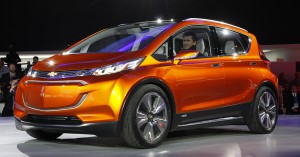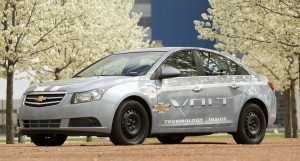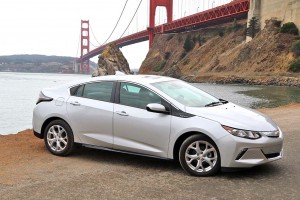When it comes to electric vehicles, it’s all about the batteries. They determine range, charging time, performance and, of course, price. And the longer the range the higher the price tag.
But General Motors believes it’s close to the proverbial paradigm shift as it gets ready to bring its new long-range Chevrolet Bolt to market. The 200-mile battery-electric vehicle is expected to have the lowest-priced batteries available, breaking a target price many experts didn’t anticipate could be reached for at least five more years.
“We’re going to be at $145 a kilowatt-hour when we launch the Bolt,” said Mark Reuss, GM’s global product development director, during a lunchtime interview.
If that holds when the electric vehicle goes into production next year, that will translate into the huge cost savings needed to bring the Chevy Bolt in at around $35,000 after federal tax incentives, potentially positioning it as the first “affordable,” long-range battery-car.
A decade ago, when work began on the first-generation Chevrolet Volt plug-in hybrid, lithium-ion batteries were generally costing as much as $1,000 per kWh. To put things into perspective, that would have meant a factory cost of up to $60,000 for the new Bolt’s 60 kWh pack. At the new price, that plunges to $8,700.
(Click Here for a review of the 2016 Chevrolet Volt.)
Those figures refer to the basic battery cells, and when you add in the packaging and various systems needed to manage and cool the Bolt’s battery pack the price is expected to jump by as much as 50%. But that still makes the new model much more competitive with a similar product using a gasoline powertrain – especially when factoring in its extended range.
Numerous industry studies have suggested that electric vehicles need to push towards 200 miles of range – or higher – to become acceptable to a mainstream consumer audience. Most current models, such as the Nissan Leaf, are limited to less than 100 miles between charges.
The exception is Tesla Motors which recently launch the P90D version of its Model S sedan, giving it about 300 miles per charge. Nissan has a 107-mile version of the Leaf coming this year, and it broadly hints it also could reach 200 miles with the second-generation Leaf just a couple years from production.
The decision by GM’s Reuss to talk hard numbers is unusual in an industry that tends to hold for lithium-ion battery pricing as something of a state secret. Prices vary widely, according to automotive insiders, and is starting to come down, most automakers now believed to be sourcing their batteries at around $400 a kWh.
Analysts with the Boston Consulting Group, among others, have said that the competitiveness of battery vehicles should jump when lithium cells drop to around $200, but how soon that will become the norm is unclear. Most experts have said that target would be a tough one to reach much before 2020.
Tesla is hoping to get there – and perhaps a bit lower – at its Gigafactory, a $5 billion battery plant it is now setting up near Reno, Nevada. But it will take time to ramp up production and achieve aimed-for economies of scale. Tesla CEO Elon Musk has hinted he doesn’t expect to reach the price levels GM is claiming anytime soon, though he also told reporters and analysts during a recent teleconference that he is “not worried.”
(Battery prices falling, but is it fast enough? Click Here for the story.)
For his part, Reuss took a shot at his widely quoted rival by noting that GM and battery partner LG Chem “didn’t spend $1 billion on a Gigafactory” to hit the $145 a kilowatt-hour mark. Exactly how they did get there, however, they aren’t saying.
And he and other GM sources cautioned that the company still spends more for the batteries it is using in its newly launched, second-generation Chevy Volt plug-in model.
That’s because Bolt and Volt use different battery designs and chemistries. The long-range electric vehicle’s lithium technology was formulated for range – what is known as “energy density,” a reference to how much power can be contained in a set volume of batteries. The Volt, as a plug-in, trades off range for a bit more acceleration – focusing on “power density,” or the amount of current it can send from the battery pack to the plug-in’s electric motors.
The new version of the Volt also gets an updated battery pack that is more compact, lighter and energy dense. But a key reason for its jump in range – to 53 miles per charge – is that engineers decided to use more of the energy stored in the battery. When the plug-in debuted in late 2009, they only allowed a motorist access to around 60% of the potential energy stored in its pack. That’s now up to around 85%, according to members of the 2016 Chevy Volt product team.
To put that into more familiar terms, the original plug-in was able to access the equivalent of about 6 gallons of gas from a 10-gallon tank. That’s now up to 8.5 gallons. Battery experts stress that using too much of the so-called state-of-charge risks reducing the long-term life of a lithium battery.
(From vacuum cleaners to battery cars? Appliance maker Dyson buys promising new battery manufacturer. Click Here for the story.)




GM stated publicly that the Gen1 Volt used a 65% SOC window. I’ve measured the SOC window through the OBD2 port and it seemed to be about 20% to 85%.. sometimes a little more from 19 to 87%.
What is your source for a 50% cost adder for the battery pack over the cell cost? I’ve heard that there probably is a 20 to 25% cost adder.
The 50% number came from Reuss and several others attending the luncheon the other day. The 20-25% figure was more the case when batteries were running $500-1000/kwh. Those “adders,” including the actual packaging and cooling systems, etc., don’t have quite the room to come down as do the cells of the battery. A 20% add-on to a $1,000 battery is $200, but even 50% of a $145 battery is $72.50. So, the add-on costs are also falling, but not as fast.
Paul E.